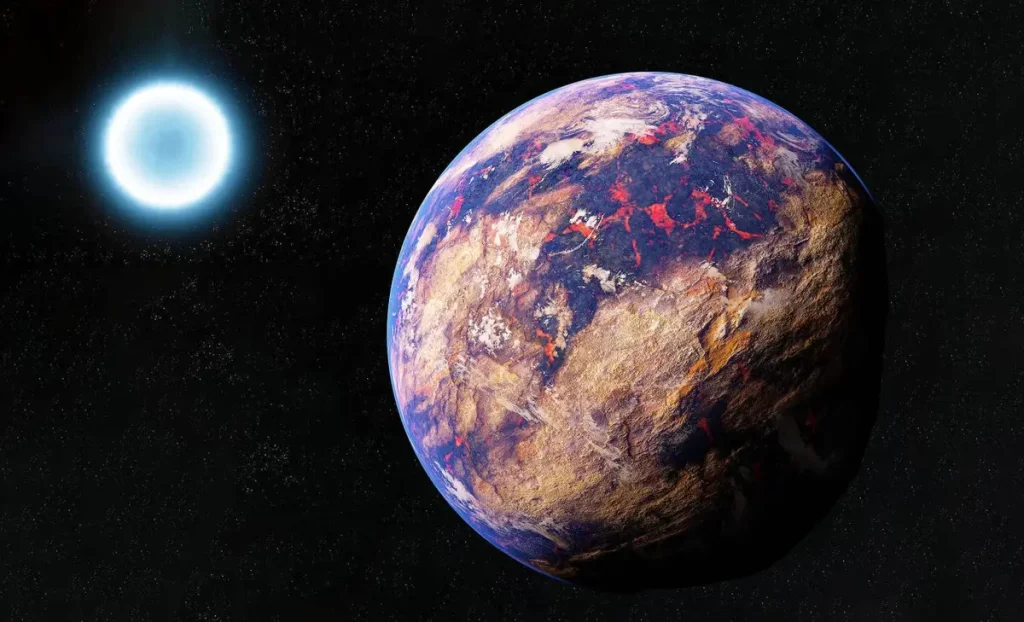Exoplanet reveals the fate of Earth in 8 billion years from now

The discovery of a rocky exoplanet located 4,000 light years away in the Milky Way provides a possible preview of Earth’s fate billions of years from now when the sun transforms into a white dwarf — leaving a frozen Earth drifting beyond Mars’ orbit.
This distant planetary system was identified by astronomers from the University of California, Berkeley, using observations with the Keck 10-meter telescope in Hawaii.
The fate of the sun-Earth system
The planetary system mirrors what scientists predict for the eventual fate of the sun-Earth system: a white dwarf, about half the mass of the sun, and an Earth-sized companion orbiting at a distance twice as far as Earth orbits the sun today. This may also be Earth’s fate.
The sun is expected to expand into a red giant, growing larger than Earth’s current orbit, engulfing Mercury and Venus in the process.
As the sun loses mass, its gravitational pull weakens, causing planets to migrate outward. Earth might escape complete destruction, moving farther from the sun.
Eventually, the sun will shed its outer layers, leaving behind a dense white dwarf no larger than Earth but still with the mass of a star. If Earth survives this process, it may end up in an orbit twice its current distance from the sun.
Evolution of main sequence stars
The new discovery helps scientists better understand how main sequence stars like the sun evolve into red giants and eventually into white dwarfs, as well as how these changes affect surrounding planets.
Some studies suggest that this process for the sun could begin in about one billion years, leading to the vaporization of Earth’s oceans and a doubling of Earth’s orbital radius – assuming Earth isn’t engulfed by the expanding sun first.
Eventually, about eight billion years from now, the sun will shed its outer layers, leaving behind a white dwarf that is about half the mass of the sun, but smaller in size than Earth.
What we know about Earth’s fate
“We do not currently have a consensus whether Earth could avoid being engulfed by the red giant sun in six billion years,” said study leader Keming Zhang, a former doctoral student at UC Berkeley, and currently a postdoctoral fellow at UC San Diego.
“In any case, planet Earth will only be habitable for around another billion years, at which point Earth’s oceans would be vaporized by runaway greenhouse effect – long before the risk of getting swallowed by the red giant.”
A story of survival
The discovered planetary system provides an example of a planet that survived, though it is far outside the habitable zone of the faint white dwarf and unlikely to support life. It may have experienced habitable conditions when its star was still sun-like.
“Whether life can survive on Earth through that (red giant) period is unknown. But certainly the most important thing is that Earth isn’t swallowed by the sun when it becomes a red giant,” said Jessica Lu, an associate professor and chair of astronomy at UC Berkeley.
“This system that Keming’s found is an example of a planet – probably an Earth-like planet originally on a similar orbit to Earth – that survived its host star’s red giant phase.”
Characterizing a distant planetary system
The distant planetary system, situated near the bulge at the center of the Milky Way, caught astronomers’ attention in 2020 when it passed in front of a more distant star, amplifying the star’s light by a factor of 1,000.
The gravity of the system acted like a lens, focusing and magnifying the light from the background star. The discovery, labeled KMT-2020-BLG-0414, was made by the Korea Microlensing Telescope Network in the Southern Hemisphere.
The background star, located about 25,000 light years from Earth, appeared as a tiny point of light. Over a period of two months, the variation in its brightness enabled scientists to characterize the planetary system.
The experts estimate that the system includes a star roughly half the mass of the sun, an Earth-sized planet, and a much larger planet around 17 times the mass of Jupiter – likely a brown dwarf, a type of failed star that doesn’t have enough mass to ignite fusion.
Mysterious identity of the host star
The analysis suggests that the Earth-sized planet orbits between one and two astronomical units from the star – about twice the distance between Earth and the sun.
However, the type of star hosting the planet remained unclear, as its light was overwhelmed by the magnified background star.
To determine the nature of the star, Zhang and his colleagues, including UC Berkeley astronomers Jessica Lu and Joshua Bloom, revisited the system in 2023 using the Keck II 10-meter telescope in Hawaii, which employs adaptive optics to correct for atmospheric blur.
Because they observed the system three years after the microlensing event, the background star’s light had dimmed enough for the lensing star to be visible, if it were a typical main-sequence star like the sun. However, Zhang found no visible star in two separate Keck images.
Stars orbited by exoplanets
“Our conclusions are based on ruling out the alternative scenarios, since a normal star would have been easily seen,” said Zhang. “Because the lens is both dark and low mass, we concluded that it can only be a white dwarf.”
“This is a case where seeing nothing is actually more interesting than seeing something,” added Lu, who also searches for microlensing events caused by free-floating stellar-mass black holes in the Milky Way.
The discovery is part of Zhang’s project to investigate microlensing events that reveal the presence of planets, with the goal of learning more about the types of stars these exoplanets orbit.
“There is some luck involved, because you’d expect fewer than one in 10 microlensing stars with planets to be white dwarfs,” Zhang explained.
Discovering new worlds through microlensing
“Microlensing has turned into a very interesting way of studying other star systems that can’t be observed and detected by conventional means, i.e. the transit method or the radial velocity method,” said Bloom.
“There is a whole set of worlds that are now opening up to us through the microlensing channel, and what’s exciting is that we’re on the precipice of finding exotic configurations like this.”
One of the main goals of NASA’s upcoming Nancy Grace Roman Telescope, scheduled for launch in 2027, is to capture light curves from microlensing events to discover exoplanets. Many of these will require follow-up observations with other telescopes to identify the types of stars hosting the planets.
“What is required is careful follow up with the world’s best facilities, i.e. adaptive optics and the Keck Observatory, not just a day or a month later, but many, many years into the future, after the lens has moved away from the background star so you can start disambiguating what you’re seeing,” Bloom added.
Fate of humanity outside of Earth
Zhang pointed out that even if Earth is eventually engulfed by the sun during its red giant phase, humanity might find refuge in the outer solar system.
Several moons of Jupiter and Saturn, such as Europa, Callisto, Ganymede, and Enceladus, contain frozen water oceans that could thaw as the sun expands.
“As the sun becomes a red giant, the habitable zone will move to around Jupiter and Saturn’s orbit, and many of these moons will become ocean planets. I think, in that case, humanity could migrate out there,” Zhang concluded.


